If you choose the wrong type of needle, it or the looper may become deformed. In this regard, First you need to read the instructions, which comes with the overlock. It contains all the necessary information regarding the system of tools that are suitable for the correct functioning of the sewing device.
General characteristics
Overlock needles are also called knitting needles because they are used for overcasting the edges of knitted garments, for example:
- sweaters;
- sporting goods;
- T-shirts.
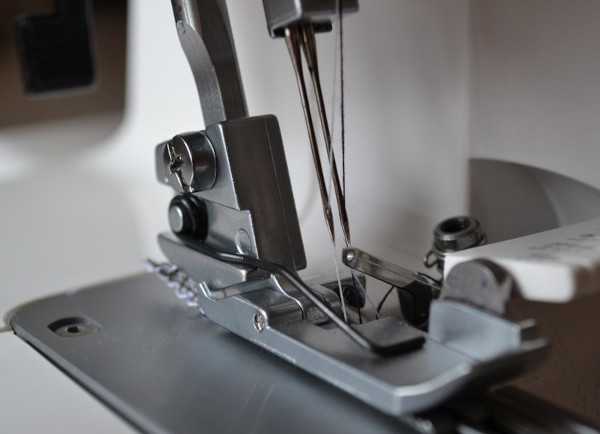
The production of tools is carried out by different companies, so the models will differ from each other in size and length. Due to this, it is permissible to set the required needle pitch during work.
Despite the large number of different types of accessories, each is characterized by the same design, consisting of:
- notches;
- ditches;
- points;
- rod;
- ear;
- shank.
Tools designed for overlock have a reinforced base and high strength, because you need to work with thick fabrics, and you also need to provide the needle with a long service life.
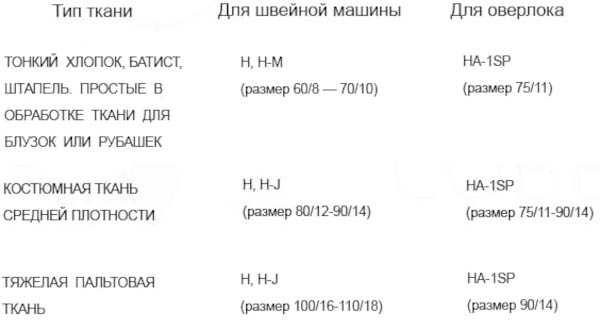
The accessory also has an additional groove to quickly remove the thread material from the needle using a looper. This minimizes the risk of missing a stitch.
Many modern household overlocks use ELx705 system needles. Unlike the universal accessory 130/705H, they have an auxiliary groove located on the back of the product.
Additionally, such a tool is characterized by a reinforced tip and high strength. Thanks to the special design, it is easy to create a stitch at high machine speeds, avoiding gaps in the line.
At the same time, due to the auxiliary groove and the beveled flask, the looper can be located as close as possible to the needle, capturing the thread material and forming a stitch. The accessory also has an enlarged eye to save the thread at high speeds.
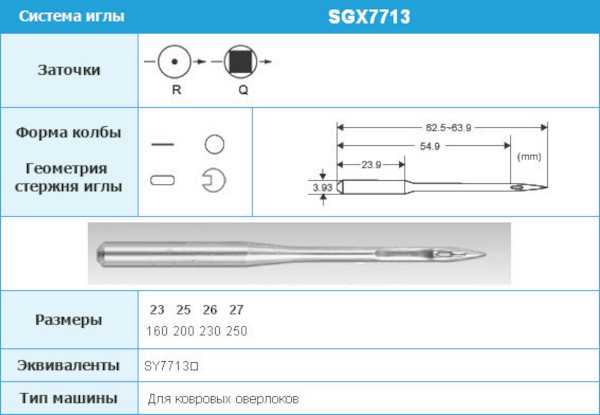
The industrial overlock tool differs from household models in the length of the accessory and the thickness of the flask, which has a round shape. In this regard, industrial needles are not suitable for use on household overlocks.
You can find out the type and brand of the tool that is intended for a specific machine model not only in the instructions, but also on the sticker located on the body or cover of the device.
The quality of the stitch without gaps depends on the condition of the tool tip. In this case, it is recommended to use a magnifying glass to check the edge of the tip, which should not be bent or blunt.
Otherwise, the tool will pierce the fabric fibers instead of passing through them to avoid deformation. This will cause the device to deteriorate in quality and damage the fabric that is intended for sewing things.
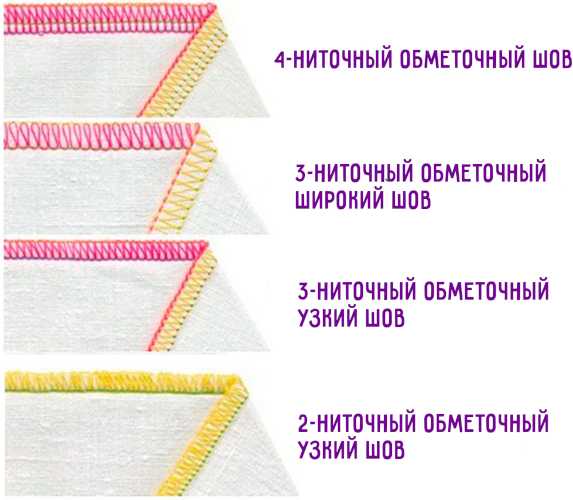
The quality of the overlock stitch also depends on the characteristics of the thread material (strength with elasticity and thickness). In addition, it is necessary to correctly thread the needle and looper of the device.
Classification
Overlock needles are made by different companies, so the tools will differ from each other in thickness, length and shape.
Standards
For working on household overlocks, ELx705 brand tools are suitable. The size of the accessory should match the density of the fabric being processed. Some companies apply not only letter markings to the tools, but also color markings, presented in the form of a colored line, which is located on the flask of the product plate.
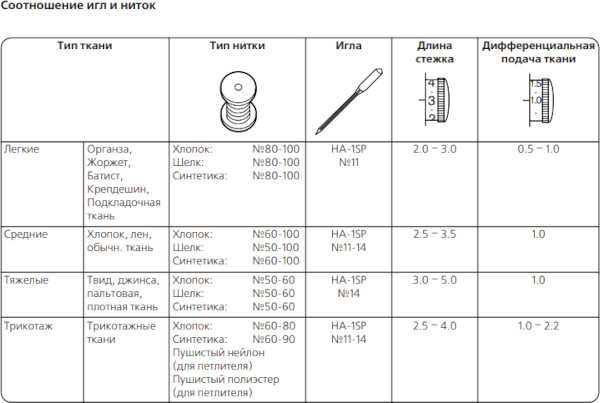
The stripe can tell you about the possibility of using the accessory for a specific task. For example, for an overlock, the needles are marked with a black shade. The length of the tool reaches 38.5 mm, which is a standard parameter. Also, the difference between accessories may be in size and type.
For work on household devices, not only standard ELx705 and HAx1SP needles can be used, but also other models:
- H-DRI (to work with 2 or 3 thread materials);
- H-LL, LR (required for leather processing);
- HO (have an auxiliary blade);
- HS (suitable for elastic materials);
- H-SUK (have a round tip).
The tool size is indicated in hundredths of a millimeter. If the accessory has a high metric number, it is suitable for processing denser fabrics. For industrial devices, brands DCx27 or B27 are suitable. The tool is selected based on the density and type of fabric.
The accessory number is often indicated on the slide or box label on the right. The number indicates the thickness of the tool.
Unlike regular sewing machine needles, household overlock tools feature a wide eye, reinforced edge, and high strength. This helps form uniform stitches without breaking the thread material during fast operation of the device.
Thickness
The tools are marked with a special code applied to the flask. Due to the letter and digital symbols, it is possible to determine the optimal equipment without using packaging. The numbers indicate the thickness of the accessory. Hundredths of a millimeter are the measuring unit.

When choosing the tool number, you need to take into account the thickness of the workpiece:
- for making coats – No. 100 and No. 110;
- for lightweight knitted material – No. 60;
- for dense fabric – No. 80 and No. 90;
- for highly elastic knitted fabrics and those containing lycra – No. 65 and No. 70;
- for elastic material of medium density – No. 75 and No. 80.
Laying parallel lines is an alternative way to process the edges. To create beautiful even lines, a double accessory designed for knitwear is suitable.
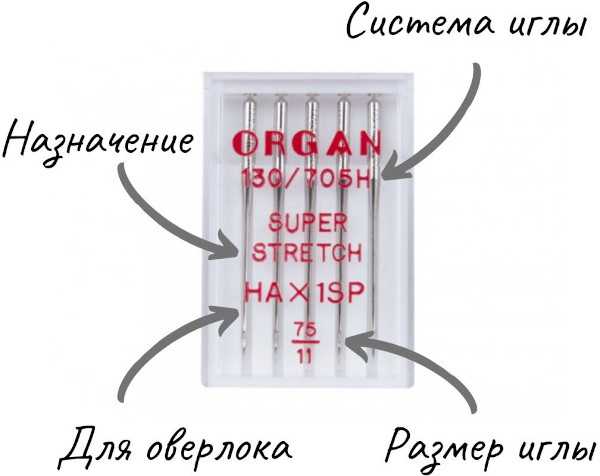
The number of such a tool mainly includes 2 parameters:
- diameter of the metal rod;
- interneedle interval.
The design is presented in the form of a common holder, fixing 2 points at a certain distance. Models No. 70, 80 and 90 are often produced with a distance between the rods of 2, 3, 4 mm, respectively.
Sharpening
To spread the fabric fibers, you need to choose the right needles. This will ensure a high-quality seam. If the selected fabric does not match the type of accessory, the fabric fibers in the puncture area of the material will stretch and turn outward, and an untidy seam will be created.
In this regard, the correct selection of the type of tool is the main requirement to obtain a high-quality line.
The purpose of the accessory is usually indicated by letters in the name. For example, if 130x705H-M is indicated, it means that the needle is suitable for thick and thin materials. In some cases, a simpler designation is provided in the form of Embroidery, Leather, Microtex, SuperStretch and Jeans.
Explanation of letter values:
| Letters | What are they suitable for? |
| H | They are a universal model with a slightly rounded end. The tool size can vary from 60 to 110, so it is suitable for ordinary materials. |
| HE | Embroidery models have a slightly rounded end, a special notch and a slightly large eye hole to prevent deformation of the thread fibers or fabric. Suitable for decorative embroidery using special embroidery threads. |
| HJ | They are intended for thick fabrics such as presents, soot, denim, and therefore have a sharp edge. |
| H-LR | They have a cutting edge designed for leather material. They make a cut at 45° towards the seam. As a result, you can achieve a decorative stitch, the stitches of which have a slight slope. |
| HM | Microtex instruments are thin and pointed. In this regard, they are suitable for precise piercing of dense and thin fabric with microfibers in the form of taffeta, silk. |
| HQ | Intended for quilting. In this case, the tool will be equipped with a small eye, a special bevel and a round end so that there are no missed stitches or punctures on the fabric. |
| H.S. | Suitable for elastic materials, therefore equipped with a slightly rounded end and a special edge that reduces skipped stitches when stretching the fabric. Suitable for sewing elastic synthetic and medium-density knitted fabrics. |
| H-SUK | They have a rounded tip to easily spread the thread loops with the fibers of the material. When passing between the fibers, the tool will not deform the fabric. They are mainly intended for processing knitted, jersey and thick knitted products. |
Manufacturers rating
Needles that are intended for use on an overlock machine are produced by different manufacturers.
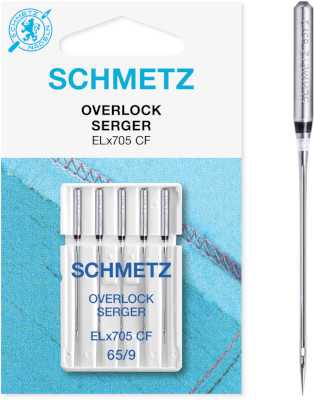
The best in terms of quality and price are:
- Gamma. The Russian company is represented by a wide range of accessories. At the same time, the needles are suitable for both overlock and regular sewing machines. The packaging should indicate "For Gamma Jersey". The accessory number for thin material can be 70-85, and for medium fabric - 90-130. Needles cost approximately 100 rubles.
- Hemline. The Australian company marks Klasse tools according to a common standard. However, it does not use standard markings. For an overlock, the packaging should indicate "Knitwear". Tool numbers: 70/10, 80/12, 90/14. You can buy the product for about 270 rubles.
- Organ Needle. The Japanese company produces tools with traditional markings and according to the general standard. ELx brand needles are suitable for overlock. You can buy them for 300-500 rubles.
- Schmetz. The products of the German company are distinguished by high standards and requirements. It produces tools by type of material. For example, ELx705 – for thin fabric, ELx705 SUK – for medium and thick materials. The cost of the product varies within 200-300 rubles.
- Artie. The Russian company uses English wire to produce accessories. The tools are characterized by a wide range of applications. For overlock work, the packaging should indicate "Overlock needle" 04 (SES), and the tool number should be 70-130. The price of the product is approximately 300 rubles.
How to choose for knitted fabrics
Overlock needles are suitable for overcasting knitted fabrics. However, the brand and type of tool must match the recommendations given by the manufacturer.
First, you need to check that the selected tool matches the device you have. For this purpose, you need to read the instructions that come with the overlock.
Additionally, when purchasing a product, you need to look at:
- quality of material;
- instrument characteristics;
- structural integrity.
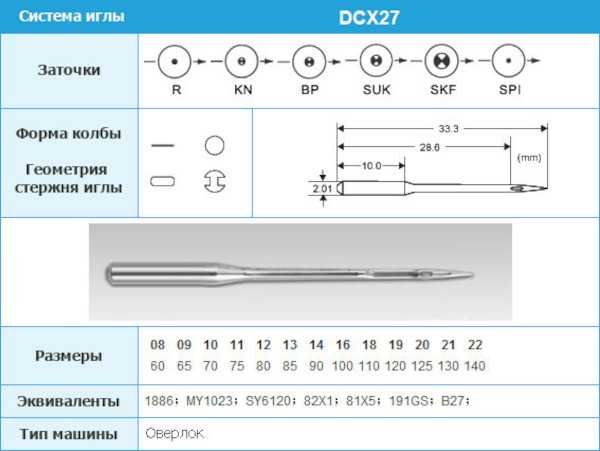
Before starting work, it is necessary to carefully examine the appearance of the accessory, because in many cases stitches are missed due to a blunt tip of the tool. To detect such a defect, it is recommended to use a magnifying glass.
Knitwear is a knitted fabric, therefore it is necessary to select needles with a rounded end. Thanks to this, during work the tool will not pierce and tear, but push apart the fabric fibers.
When using universal needles, it is permissible to leave arrows, small holes or other defects near the stitching. As a result, the fabric can be damaged.
For knitted fabrics, several needles with markings are suitable:
- Jersey. Suitable for processing knitted materials, jersey and dense knitted fabrics. The tool should be equipped with a rounded tip so as not to pierce the fabric and carefully move apart the loops with fibers.
- Stretch and Super Stretch. Designed for processing highly elastic materials such as noodles, biflex and knitwear containing lycra. Due to the special design, the tool will not make gaps and will also allow you to get a beautiful seam.

Additionally, when selecting an accessory for knitted fabrics, you need to look at the number indicating the thickness of the needle:
- No. 60-75 are suitable for processing thin knitted fabrics such as interlock and jersey;
- No. 80-85 are intended for sewing 2-thread footer;
- No. 90 is suitable for dense knitted materials in the form of 3-thread footer with loop and fleece.
When choosing a double needle, you need to take a product marked Stretch. In this case, the tool number must match the thickness of the material.
Needles are a special accessory for sewing. Today, many companies produce different types of tools that are designed to perform different tasks.
Overlock needles differ from regular tools that need to be installed on sewing machines in the shape and thickness of the flask. In this regard, before purchasing the product, you need to make sure that the type of accessory has been selected correctly.
Video about overlock needles
What needles are needed for an overlock:
